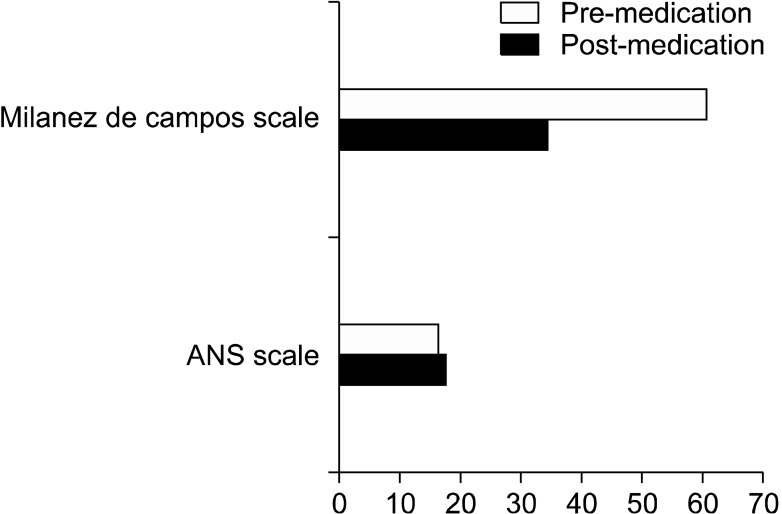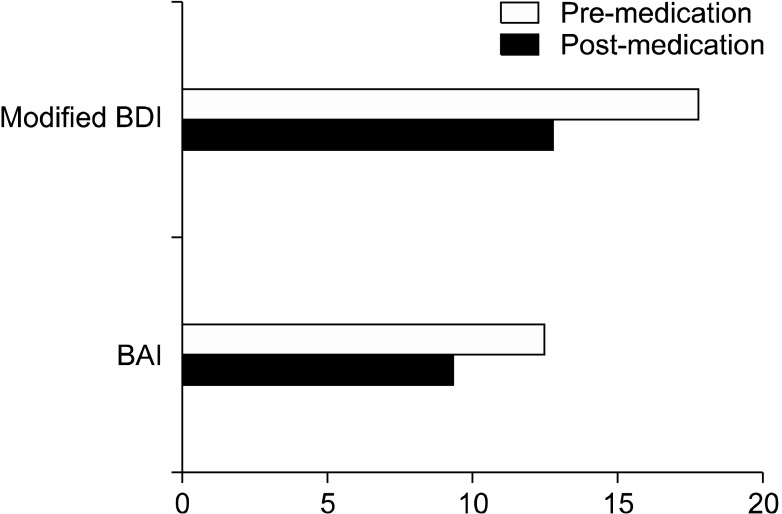Korean J Pain.
2013 Jan;26(1):89-93. 10.3344/kjp.2013.26.1.89.
Effectiveness of Oral Glycopyrrolate Use in Compensatory Hyperhidrosis Patients
- Affiliations
-
- 1Department of Anesthesiology and Pain Medicine, Ajou University College of Medicine, Suwon, Korea. sepsis21c@naver.com
- KMID: 1779032
- DOI: http://doi.org/10.3344/kjp.2013.26.1.89
Abstract
- Compensatory hyperhidrosis or reflex hyperhidrosis is the increase in sweating in the postoperative stage of thoracic sympathectomy or lumbar sympathectomy. It shares several features with anxiety disorders and has a negative impact on a patient's quality of life. Oralglycopyrrolate is one of the treatment options available. This study reviewed case notes in a series of 19 patients with compensatory hyperhidrosis. We made a comparison between the Milanez de Campos score of a pre-glycopyrrolate medication group and the Milanez de Campos score of a post-glycopyrrolate medication group. The Beck Depression Inventory (BDI) score, Beck Anxiety Inventory (BAI) score, and autonomic nervous system (ANS) scale score were also compared between the pre-medication and post-medication groups. In the post-glycopyrrolate medication group, there was decrease in the Milanez de Campos score, BAI score, and BDI score (P < 0.05). But no meaningful change was seen in the ANS score in the post-glycopyrrolate medication group (P > 0.05). Glycopyrrolate is an effective medication in the treatment of compensatory hyperhidrosis that, can alleviate anxiety and improve patients' quality of life.
MeSH Terms
Figure
Reference
-
1. Sato K, Kang WH, Saga K, Sato KT. Biology of sweat glands and their disorders. II. Disorders of sweat gland function. J Am Acad Dermatol. 1989; 20:713–726. PMID: 2654213.
Article2. Kim WO, Yoon DM, Kil HK, Kim JI, Choi BI. Effect of oral glycopyrrolate in essential hyperhidrosis. Korean J Anesthesiol. 2004; 46:298–301.
Article3. Lai YT, Yang LH, Chio CC, Chen HH. Complications in patients with palmar hyperhidrosis treated with transthoracic endoscopic sympathectomy. Neurosurgery. 1997; 41:110–113. PMID: 9218302.
Article4. Adar R, Kurchin A, Zweig A, Mozes M. Palmar hyperhidrosis and its surgical treatment: a report of 100 cases. Ann Surg. 1977; 186:34–41. PMID: 879872.5. Chou SH, Kao EL, Li HP, Lin CC, Huang MF. T4 sympathectomy for palmar hyperhidrosis: an effective approach that simultaneously minimzes compensatory hyperhidrosis. Kaohsiung J Med Sci. 2005; 21:310–313. PMID: 16089308.
Article6. Fredman B, Zohar E, Shachor D, Bendahan J, Jedeikin R. Video-assisted transthoracic sympathectomy in the treatment of primary hyperhidrosis: friend or foe? Surg Laparosc Endosc Percutan Tech. 2000; 10:226–229. PMID: 10961751.
Article7. Lin TS, Wang NP, Huang LC. Pitfalls and complication avoidance associated with transthoracic endoscopic sympathectomy for primary hyperhidrosis (analysis of 2200 cases). Int J Surg Investig. 2001; 2:377–385.8. Gossot D, Galetta D, Pascal A, Debrosse D, Caliandro R, Girard P, et al. Long-term results of endoscopic thoracic sympathectomy for upper limb hyperhidrosis. Ann Thorac Surg. 2003; 75:1075–1079. PMID: 12683540.
Article9. Lin CC, Telaranta T. Lin-Telaranta classification: the importance of different procedures for different indications in sympathetic surgery. Ann Chir Gynaecol. 2001; 90:161–166. PMID: 11695784.10. Lyra Rde M, Campos JR, Kang DW, Loureiro Mde P, Furian MB, Costa MG, et al. Guidelines for the prevention, diagnosis and treatment of compensatory hyperhidrosis. J Bras Pneumol. 2008; 34:967–977. PMID: 19099105.11. de Campos JR, Wolosker N, Takeda FR, Kauffman P, Kuzniec S, Jatene FB, et al. The body mass index and level of resection: predictive factors for compensatory sweating after sympathectomy. Clin Auton Res. 2005; 15:116–120. PMID: 15834768.12. Nascimento LP, Raffin RP, Guterres SS. Aspectos atuais sobre a segurança no uso de produtos antiperspirantes contendo derivados de aluminio. Infarma. 2004; 16:66–72.
- Full Text Links
- Actions
-
Cited
- CITED
-
- Close
- Share
- Similar articles
-
- Treatment of Compensatory Gustatory Hyperhidrosis with Topical Glycopyrrolate
- Effect of Oral Glycopyrrolate in Essential Hyperhidrosis
- Efficacy of Glycopyrrolate in Primary Hyperhidrosis Patients
- A Case of Unilateral Compensatory Hyperhidrosis Developed after Thoracotomy
- Sympathetic Nerve Reconstruction for Compensatory Hyperhidrosis after Sympathetic Surgery for Primary Hyperhidrosis



